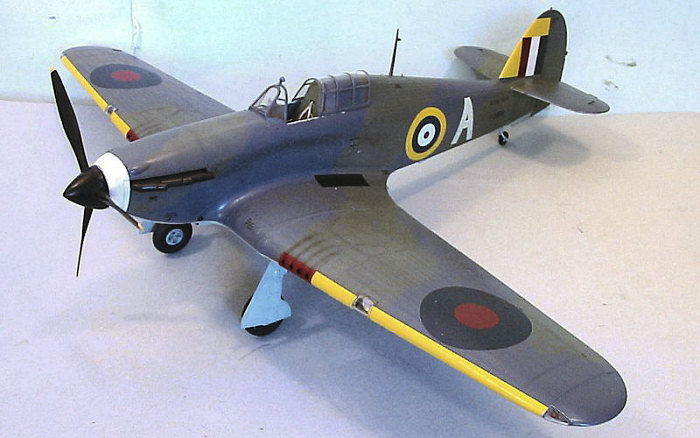
| KIT: | Trumpeter 1/24 Sea Hurricane I |
| KIT #: | ? |
| PRICE: | $139.95 MSRP |
| DECALS: | Two options |
| REVIEWER: | Tom Cleaver |
| NOTES: |

| HISTORY |
Though the Spitfire gained the glory of the Battle of Britain, it was the tough Hawker Hurricane that won the fight. Three-fifths of the squadrons of RAF's Fighter Command were mounted on Sidney Camm's fighter that summer of 1940. Badly outperformed by the Bf-109E, it was a scandal when reports came out that production Hurricane I's could barely make 305 mph at 10,000 feet - the height at which most combat occurred - and that the airplane could not be flown over 20,000 feet, the altitude from which the Messerschmitts dove out of the sun on their targets. Be that as it may, the rugged, somewhat primitive Hurricane was the more easily-repaired of the two RAF fighters; fully 60 percent of the Hurricanes shot down over England that summer were repaired and returned to operational use during the battle - a fact that Goering's Luftwaffe missed as they confidently predicted that September 15, 1940, would see no RAF fighters over London.
Outclassed or not, the Hurricane I was there when it was needed, in numbers sufficient to change the outcome of a battle nearly everyone expected Britain to lose. As such, it is a model deserving of a place of distinction in any collection.
The Sea Hurricane:
The Fleet Air Arm suffered throughout the early years of the war for the lack of a carrier-based fighter that had performance sufficient to face the land-based Axis air forces. This was nowhere more apparent than in the Mediterranean, where Axis air units were never more than an hour away from any Royal Navy units operating outside of land-based fighter coverage from Gibraltar in the west or Alexandria in the east.
In 1941, it was decided to modify semi-obsolescent Hawker Hurricane I fighters which had been superceded in Fighter Command to enable them to operate at sea. With its wide landing gear and relatively simple airframe, the Hurricane was capable of taking the stresses of carrier operations. After 60 were modified as Sea Hurricane Ia’s for operation as catapult fighters, the Sea Hurricane Ib was created, with catapult spools and an A-frame arrester hook. The Sea Hurricanes first saw action with 800 Squadron in May 1941, and its career was made in the defense of the Malta Convoys, and most unforgettably in the incredible story of the greatest Malta Convoy of all.
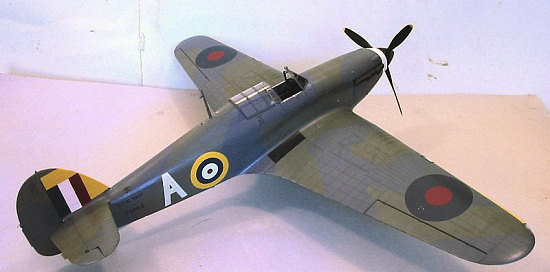 Operation
Pedestal:
Operation
Pedestal:
By July 1942, the island of Malta had been under nearly unrelenting attack by the Italian and German air forces for two years. The island’s strategic position was such that whoever controlled it would ultimately control the outcome of the war in North Africa. So important was Malta that in the spring of 1942, the Germans had considered mounting an airborne invasion.
For the British, resupplying Malta meant mounting major convoys with as many capital ships as possible for escort, due to the proximity of the Italian Navy and the presence of German and Italian air units on Sicily less than 100 miles away from the shipping lanes, which put the ships at incredible risk.
The first convoy was sent in September, 1941. Eight of the nine merchant ships survived attacks by the Regia Aeronautica to bring in 85,000 tons of supplies. In February, 1942, a convoy of three ships from Alexandria was unsuccessful, with the survivors turning back in the face of Axis opposition, and no supplies reached Malta. A convoy sent from Gibraltar in March, 1942, consisted of three merchant ships and a Navy oiler, accompanied by four cruisers and sixteen destroyers, while a fifth cruiser and four destroyers sailed from Malta. The escort was successful in keeping the keeping the Italian battleship Vittorio Veneto, three cruisers and ten destroyers at bay. But near Malta, the newly-arrived German Fliegerkorps X struck the convoy south of Sicily, sinking one of the merchant ships only 20 miles from Malta, and sinking the oiler eight miles from Valetta Harbor. The two surviving ships made it into harbor only to be sunk with only a small fraction of their cargo unloaded.
Another convoy had to be mounted. The most important element of the entire operation would be getting a tanker in to Malta to provide gasoline and diesel fuel. The British had no tankers capable of maintaining the speed necessary to give the ship a fighting chance of making it through, and an appeal was made to Franklin Roosevelt that May. Roosevelt turned over the SS Ohio and SS Kentucky to the British. At the time they were the largest and fastest tankers in the world. Launched April 20, 1940 at Sun Shipbuilding Yard in Chester, Pennsylvania, for the Texas Oil Company, Ohio and her sister ships were built in anticipation of war and were the result of unofficial conversations between the American military and the oil company. At 9,263 tons and 485 feet long, Ohio and her sister ships, Oklahoma, Kentucky, Colorado, Montana, Georgia, Delaware, and Indiana each held 170,000 barrels of oil. With 9,000 shaft horsepower Westinghouse turbine engines, they were rated at 16 knots. However, Ohio had managed 19 knots in sea trials.
 In June, 1942, plans were
made to use as many British warships as could be scraped together to protect as
large a convoy as could be organized, with ships coming from both Gibraltar and
Alexandria. The Gibraltar convoy of six included the Kentucky and was
escorted by a battleship, two aircraft carriers and four cruisers. The
Alexandria convoy of eleven merchant ships was escorted by eight cruisers. The
capital ships withdrew before the convoys reached the narrow seas between Sicily
and North Africa, leaving support to the anti-aircraft cruiser HMS Cairo
and 13 destroyers. Under relentless attack from German and Italian dive bomber
units, six merchant ships were sunk, three were heavily damaged, and seven
turned back. Only two ships arrived in Malta, and the Kentucky wasn’t one
of them. The convoy had been a failure.
In June, 1942, plans were
made to use as many British warships as could be scraped together to protect as
large a convoy as could be organized, with ships coming from both Gibraltar and
Alexandria. The Gibraltar convoy of six included the Kentucky and was
escorted by a battleship, two aircraft carriers and four cruisers. The
Alexandria convoy of eleven merchant ships was escorted by eight cruisers. The
capital ships withdrew before the convoys reached the narrow seas between Sicily
and North Africa, leaving support to the anti-aircraft cruiser HMS Cairo
and 13 destroyers. Under relentless attack from German and Italian dive bomber
units, six merchant ships were sunk, three were heavily damaged, and seven
turned back. Only two ships arrived in Malta, and the Kentucky wasn’t one
of them. The convoy had been a failure.
It was now time to do or die. If a convoy didn’t get through to Malta by mid-August, the island would run out supplies and be forced to surrender. What became known as Operation Pedestal was the largest of the Malta Convoys and would result in the biggest naval battle of the war in the Mediterranean.
Eighty ships, including fourteen merchantmen and the tanker Ohio, and 64 Royal Navy warships including four aircraft carriers, were involved. One carrier, HMS Furious, had the assignment of going in ahead of the convoy and flying off Spitfires to Malta, that could help provide air cover for the ships on their final run in to the island, when the escorting carriers would have to retire. This came on top of several successful runs to supply fighters to Malta in preceding months.
The largest fighter force in Fleet Air Arm history to that date was assembled aboard the three fleet carriers that would provide the heart of the escort. HMS Eagle carried the Sea Hurricanes of 801 and 813 Squadrons. HMS Victorious carried the Fulmars of 809 and 884 Squadron and six Sea Hurricanes from 885 Squadron. The most experienced were the fighters aboard HMS Indomitable , which included Sea Hurricanes of 800 Squadron led by FAA ace LCDR Bill Bruen, while “Butch” Judd led the Sea Hurricanes of 880 Squadron with Battle of Britain FAA ace “Dickie” Cork as his flight commander. 806 Squadron with Grumman Martlet IIs came aboard at the last minute.
The convoy left Gibraltar and entered the Mediterranean on August 10, 1942. It was expected to take four days for the ships to make the trip to Malta, and that air attacks could be expected beginning on the second day. The convoy was almost immediately spotted by a French civilian flight from Algeria, and its report was picked up by the Germans, who now were ready. Furious broke off and made her high speed run-in, launching 36 Spitfires at dawn on August 12.
On
August 11, shortly after Furious departed, disaster struck the main
convoy when U-73 sent four torpedoes into Eagle. Sinking within minutes,
the carrier took 260 men and all but four of the crucial Sea Hurricanes.

At about the same time as Furious was launching her Spitfires on August 12, a Ju-88 spotted the main convoy. Within two hours, the Sea Hurricanes, Fulmars and Martlets of the surviving carriers were in action against a total of 40 Ju-88s, which they mostly managed to hold off. During the day’s fighting, seven FAA pilots would “make ace,” one of whom was a sitting Member of Parliament, an indication of how hard-fought the battle was. Over 100 German and Italian aircraft would attack during the day in a total of six different attacks, with the fighters making claims for 28 destroyed and another 12 damaged, including five in a day by Dickie Cork, the only FAA pilot during the war to score “ace in a day.” Two squadron commanders were lost in battle. The fleet lost the cruisers Cairo and Nigeria torpedoed by Italian submarines, with Cairo abandoned. S.S. Ohio had been torpedoed by an Italian submarine that morning and her speed reduced to 13 knots, forcing the entire convoy to slow. Empire Hope, one of several ships carrying aviation gasoline, had been bombed and set afire, and sunk by the escort. That night, as the convoy approached the Sicilian Narrows, Victorious and Indomitable and their escorts peeled off to return to Gibraltar.
The real battle now began. S.S.Ohio was the main target. The fleet passed through the minefields between Africa and Sicily at midnight. Shortly thereafter, eight Italian MTBs made 15 attacks, hitting the cruiser Manchester, and the S.S. Santa Elisa, the other American ship in the convoy and the second ship carrying aviation gasoline, which was abandoned after she caught fire. Two British merchantmen were sunk, while the Rochester Castle was hit but kept going.
At 0400 fighters from Malta arrived overhead but were unable to blunt the attack of 20 Ju-88s, and the Waimarana, also carrying avgas, was hit and sunk. This was followed shortly by 60 Stukas, which focused their attack on the Ohio. Near misses buckled her plates and the forward tanks filled with water. By 1050, her boilers were blown and she was dead in the water. The entire purpose of Operation Pedestal faced disaster.
The attacks continued throughout the day. The cruiser Dorset was hit by three near misses and abandoned when fire broke out. HMS Kenya narrowly avoided a similar fate when her crew was able to put out the fires in her forward engine room. The merchantmen Rochester Castle, Port Castle, and Melbourne Star steamed on to meet escort from Malta and reached Grand Harbor in Valetta at 1800.
The plucky Ohio refused to sink. The destroyer HMS Ledbury came alongside to attempt a tow, but the ship wanted to move sideways. During the five hour attempt, a Ju-88 - hit by anti-aircraft fire - crashed onto the foredeck, while a Stuka that hit the water bounced, slammed into the tanker and exploded. After avoiding mines and torpedoes, Ohio was straddled by two bombs that lifted her out of the water as her keel was cracked. At this point, the crew abandoned ship in the expectation she would break in half.
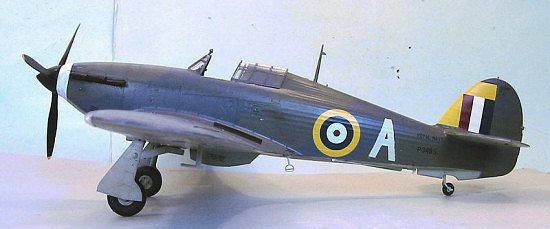 On the morning of August
14, Ohio was still afloat, though by this time the ocean was washing over
her main deck. A decision was made to attempt a second tow and two British
destroyers moved in. At this time, Third Mate Frederick Larsen, Jr. and Francis
Dales, Cadet-Midshipman from the U.S. Merchant Marine Academy - crew members on
the from the sunken S.S. Santa Elisa who had been rescued by HMS
Ledbury - volunteered to board the Ohio and examine her as HMS
Ledbury and a second destroyer, HMS Penn, prepared to lash themselves
to either side of the Ohio and bring her on to Malta. HMS Bramham
and the minesweeper HMS Rye stood by to take forward tow.
On the morning of August
14, Ohio was still afloat, though by this time the ocean was washing over
her main deck. A decision was made to attempt a second tow and two British
destroyers moved in. At this time, Third Mate Frederick Larsen, Jr. and Francis
Dales, Cadet-Midshipman from the U.S. Merchant Marine Academy - crew members on
the from the sunken S.S. Santa Elisa who had been rescued by HMS
Ledbury - volunteered to board the Ohio and examine her as HMS
Ledbury and a second destroyer, HMS Penn, prepared to lash themselves
to either side of the Ohio and bring her on to Malta. HMS Bramham
and the minesweeper HMS Rye stood by to take forward tow.
After several hours this was accomplished. As the three ships began moving at a speed of 3 knots, with Ohio threatening at any minute to break apart, and with German divebombers tipping over to attack, Larsen and Dales, accompanied by a British Gunner’s mate and three ratings, found a 20mm anti-aircraft gun that was still operable aboard Ohio. All three ships at this point were under continuous dive bomber attack. Larsen took the trainer’s position while Dale and the Gunner’s Mate alternated as pointers. Over the course of the day they were responsible for shooting down four Stukas and damaging several others.
At the end of the day, a lucky German bomb went down Ohio’s stack and blew out the bottom of her engine room. One more attack would sink the ship. Darkness intervened and the desperate tow continued throughout the night as HMS Bramham and the minesweeper HMS Rye moved to prevent the ubiquitous Italian torpedo boats from approaching the three ships.
 Dawn broke with Malta in sight. More attacks were attempted without success,
and at 0930 Ohio and her two British saviors entered the Grand Harbor.
The Operation Pedestal convoy is known in Maltese history as "Il-Konvoj ta
Santa Marija" because it arrived on St. Mary’s feast day.
Dawn broke with Malta in sight. More attacks were attempted without success,
and at 0930 Ohio and her two British saviors entered the Grand Harbor.
The Operation Pedestal convoy is known in Maltese history as "Il-Konvoj ta
Santa Marija" because it arrived on St. Mary’s feast day.
Larsen and Dales received the Merchant Marine’s Distinguished Service Medal. The citation concluded, “The magnificent courage of this young third officer and cadet-midshipman constitutes a degree of heroism which will be an enduring inspiration to seamen of the United States Merchant Marine everywhere.”
Operation Pedestal was the most important British naval victory in the
Mediterranean. 400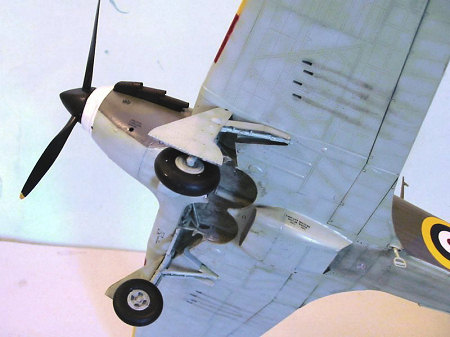 Royal Navy sailors and merchant mariners gave their lives in the attempt. The
Fleet Air Arm and the Malta air forces claimed 39 aircraft destroyed, and an
Italian submarine sunk by the surface force.
Royal Navy sailors and merchant mariners gave their lives in the attempt. The
Fleet Air Arm and the Malta air forces claimed 39 aircraft destroyed, and an
Italian submarine sunk by the surface force.
Ohio took seven direct hits and twenty near misses, but was still able to deliver most of her original cargo of 12,000 tons of diesel and aviation gasoline. Her captain, Dudley William Mason, was awarded the George Cross. After Ohio reached Malta, the ship broke in two from the damage she had sustained. There were insufficient shipyard facilities to repair her, so the two halves were used for storage, and later as barracks facilities for Yugoslav troops. On September 19, 1946, the two halves were towed ten miles off the coast, and sunk by naval gunfire. The aft section sank first, followed by the forward half.
By the end of September, 1942, the resupplied air forces on Malta had been able to attack Axis convoys to North Africa so successfully that Rommel’s supplies of gasoline and diesel fuel were cut in half. This had a direct on Rommel’s defeat at El Alamein, which led to the expulsion of Axis forces from North Africa. Thus, the success of Operation Pedestal was of strategic importance and led to the entire change of Allied fortunes in the Mediterranean theater.
| THE KIT |
Trumpeter’s big Hurricane has been anticipated for some six months now. Given the company’s history with their other 1/24 kits, only two of which - the Fw-190D-9 and the Bf-109G-6 - had mistakes that could be completely fixed (unlike the P-51D, the Zero and the Spitfire), there was a certain level of trepidation about the kit - what would the faults be?
Well, now that the box has been opened, the only obvious faults are that the kit comes with a prop for the Hurricane II - which makes a certain amount of sense since the other announced release is a Hurricane IID - and the lack of the circular core in the radiator. The latter is something 90 percent of those who look at the completed model will miss, and the former is something easily solved with a sanding stick and ten minutes of the modeler’s time.
 In fact, this might be the
best Hurricane kit released. The fabric surface detail of the ailerons,
vertical fin and rudder, and the horizontal stabilizer and elevators, is very
nicely restrained, while the fabric detail on the rear fuselage looks very close
to what I see when I look at the 1:1 Hurricane out at Planes of Fame. Yes,
there are engraved rivets, but they are very restrained, like the SBD Dauntless
and the Me-262 kits, and the surface looks “accurate” to me in the same way the
SBD kit’s surface detail does when compared to the real thing.
In fact, this might be the
best Hurricane kit released. The fabric surface detail of the ailerons,
vertical fin and rudder, and the horizontal stabilizer and elevators, is very
nicely restrained, while the fabric detail on the rear fuselage looks very close
to what I see when I look at the 1:1 Hurricane out at Planes of Fame. Yes,
there are engraved rivets, but they are very restrained, like the SBD Dauntless
and the Me-262 kits, and the surface looks “accurate” to me in the same way the
SBD kit’s surface detail does when compared to the real thing.
The cockpit is nicely detailed, and a photoetched seatbelt harness is provided - a good thing since there are no 1/24 aftermarket seatbelts I am aware of. This is the only Hurricane kit that gets the area of the cockpit underneath the canopy at the immediate rear correct.
The Merlin engine provides a good basis for anyone who wants to super-detail the engine. The lower side panels are provided in clear plastic for those who want to display the engine.
The decals suck, but that’s a given with Trumpeter. The red and blue is much too bright, and the squadron codes for Ian Gleed’s “Felix” of 87 Squadron and Robert Stanford-Tuck’s airplane from 257 Squadron are done in white, rather than the correct medium sea grey. Fortunately, there are some 1/24 decal sheets available - most prominently two sheets from Techmod for Hurricanes flown by 303 and 306 Squadrons in the Battle of Britain - that get the colors right.
| CONSTRUCTION |
While the kit is large and daunting-looking in the box, it is really no more
difficult than the 1/48 Hasegawa Hurricane to construct. As is usual with
Trumpeter, there are a lot of parts that make me wonder why they are there, such
as the gas tanks inside the wings, which are never going to be seen. The nicely
detailed gun bays and their weapons would provide the basis for
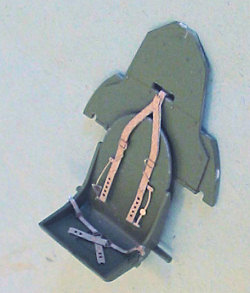 some super-detailing, which
would be necessary in this large scale. The same is true of the engine. This
is a very well-done Merlin engine, and the spark plug wiring is even included,
but there would be a need to scratchbuild the inner structure of the cowling
that the panels attach to. Any modeler who wanted to do all this would be
rewarded with a great-looking model, but a great deal of work would be required.
some super-detailing, which
would be necessary in this large scale. The same is true of the engine. This
is a very well-done Merlin engine, and the spark plug wiring is even included,
but there would be a need to scratchbuild the inner structure of the cowling
that the panels attach to. Any modeler who wanted to do all this would be
rewarded with a great-looking model, but a great deal of work would be required.
Myself, I was interested in building a basic model, so other than the engine - which was needed as a base on which to mount the exhausts and the prop - I left out all the detailed parts one wouldn’t see. When it came to assembling the wings, it turned out that the open gun panels would be better used open, since there was some fit difficulty that meant I had to use Mr. Surfacer around the joints to adequately fill them on the wing surface.
Past that, there was really no difficulty in assembling the model, other than to
find a space l arge enough to set
it at the conclusion of each session. One could also super-detail the cockpit
with electrical wiring and such. As it is, the cockpit is about as detailed as
the Hasegawa kit - in part this is due to the fact that the Hurricane has a very
simple cockpit. I decided not to use the kit-supplied photo-etch harness, and
instead used the Eduard 1/32 RAF Early Style harness, which is just enough
oversized in 1/32 scale (as are a lot of seatbelt sets in any scale) that it
looked very close to the harness in the cockpit of the Hurricane II out at
Chino. I also drilled out the instrument faces in the clear instrument panel,
since painting around the clear glass was too much trouble in my experience of
having tried this with the instrument panel on the Trumpeter 1/24 Fw-190D-9.
arge enough to set
it at the conclusion of each session. One could also super-detail the cockpit
with electrical wiring and such. As it is, the cockpit is about as detailed as
the Hasegawa kit - in part this is due to the fact that the Hurricane has a very
simple cockpit. I decided not to use the kit-supplied photo-etch harness, and
instead used the Eduard 1/32 RAF Early Style harness, which is just enough
oversized in 1/32 scale (as are a lot of seatbelt sets in any scale) that it
looked very close to the harness in the cockpit of the Hurricane II out at
Chino. I also drilled out the instrument faces in the clear instrument panel,
since painting around the clear glass was too much trouble in my experience of
having tried this with the instrument panel on the Trumpeter 1/24 Fw-190D-9.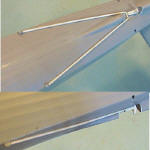
I had decided I wanted to do a Sea Hurricane, which involved modifying the kit with an arrester hook. I cut out the section of the ventral fin where the hook rides, filled in the subsequent gaps with Evergreen sheet, and made the simple tail hook using Evergreen rod for the arms and Evergreen sheet to make the hook. I also needed to create a DeHavilland prop, since the Sea Hurricane never used the bulbous-spinner Rotol prop. The blades came from the Airfix 1/24 Spitfire, and the spinner (with modification for shape) from a Revell 1/32 P-38.
While the kit has separate control surfaces, I decided to leave the controls in the neutral position because the elevators did not look entirely right when drooped.
| COLORS & MARKINGS |
Painting:
I
first painted the vertical fin and the leading edges of the wings with
Xtracrylix British Trainer Yellow. I then masked these, and proceeded to
pre-shade the model by airbrushing flat black over the panel lines in broad
coverage. The camouflage was done
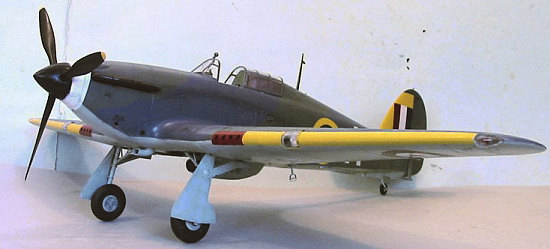 with Xtracrylix Extra Dark Sea
Grey, Dark Slate Grey and Sky. I used Dark Sea Grey and Light Slate Grey to
lighten the respective colors to go back over the surface and give some
sun-fading and weathering to the paint. With a model this big, leaving even
multiple camouflage colors in monochrome is very noticeable.
with Xtracrylix Extra Dark Sea
Grey, Dark Slate Grey and Sky. I used Dark Sea Grey and Light Slate Grey to
lighten the respective colors to go back over the surface and give some
sun-fading and weathering to the paint. With a model this big, leaving even
multiple camouflage colors in monochrome is very noticeable.
Decals:
As stated above, the kit decals suck, with the red much to bright. Fortunately, I had a Techmod sheet for the Hurricane, and used the national insignia from that here, modifying the fin flash by cutting it to the later version applied after the Battle of Britain. I used decals from the Fisher Sea Fury for the “Royal Navy” and the serial number, and used both the Trumpeter and the Techmod stencil decals. I didn’t have any ID letters in the correct size, so I used the white “A” from the Trumpeter sheet and then hand-painted it with Xtracrylix Sky, which can be applied as smoothly with a brush as with an airbrush.
| FINAL BITS |
I used Tamiya “Smoke” to do the exhaust and oil stains inside the wheel wells. I then attached the landing gear and prop, and unmasked the canopy, gluing it in the open position.
| CONCLUSIONS |
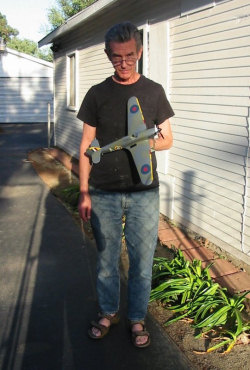 Overall, this kit looks no
more difficult to assemble than the 1/48 Hasegawa Hurricanes, with the result
being a big, accurate model of one of the most famous airplanes in history.
(How big is it? The accompanying picture of me holding the model gives an idea
of size. I am 6 feet tall and weigh 160 pounds. It’s a big model but not a
heavy one) Personally, I am not that interested in this scale, with the only
other 1/24 kit I have ever built being the Trumpeter Fw-190D-9, but this big
Hurricane was a lot of fun and looks very impressive when finished. Now if
they’d just do it in 1/32 scale...
Overall, this kit looks no
more difficult to assemble than the 1/48 Hasegawa Hurricanes, with the result
being a big, accurate model of one of the most famous airplanes in history.
(How big is it? The accompanying picture of me holding the model gives an idea
of size. I am 6 feet tall and weigh 160 pounds. It’s a big model but not a
heavy one) Personally, I am not that interested in this scale, with the only
other 1/24 kit I have ever built being the Trumpeter Fw-190D-9, but this big
Hurricane was a lot of fun and looks very impressive when finished. Now if
they’d just do it in 1/32 scale...
Thanks to Stevens International for the review kit.
May 2007
If you would like your product reviewed fairly and quickly by a site that has over 350,000 visitors a month, please contact me or see other details in the Note to Contributors.